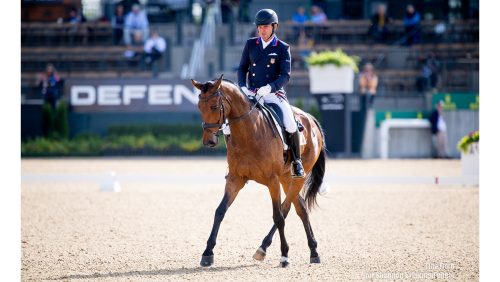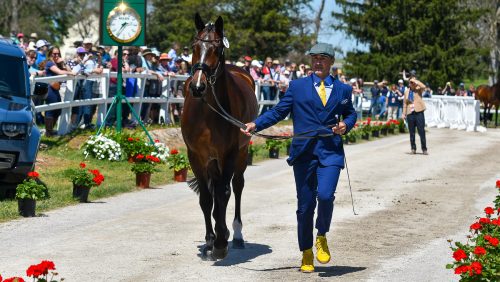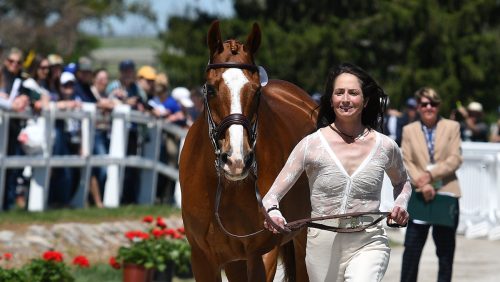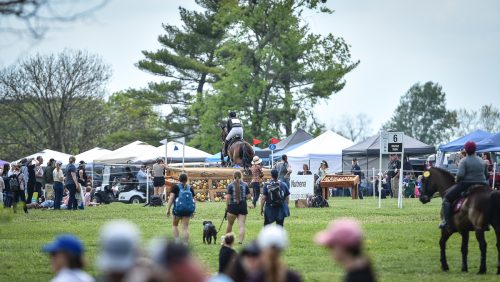A few years ago, I tried something totally new and it gave me an incredibly fresh perspective on the amount of bravery it takes for students to crawl up on the back of a 1,200-pound free-thinking mammal and learn about self-control and practice fundamentals as they prance around the dressage arena and over fences.
My journey was sparked by some now-welcomed peer pressure and gave me an insane amount of insight on how fitness and the learning process translates to the student, both human and equestrian.
Learning The Dance
CrossFit is constantly varied functional movements performed at high intensity. I had no idea what this meant when I agreed to go, but it sounded good. Turns out this involves a wide variety of skills including weight lifting, cardio, and gymnastics.
When I walked into the CrossFit gym, I was overwhelmed, singled-out, and felt that I had a million people watching to see just how badly I was going to butcher the technique as I handled an awkward barbell for the first time. A million people was a bit of an overstatement, as there were only three people in the class, but nonetheless, the spotlight syndrome was activated.
I picked up the barbell with delicacy, stumbled under the weight of picking it up, and looked for guidance from anyone who would make eye contact. I followed along with step-by-step procedures for each of the activities, and I was elated to see even the most active (read: SUPER BUFF) fellow classmates put as much into the warm up and practice of the basics as they did when they had 300 lbs. on the bar.
Just like when I am learning on new-to-me horses, my barbell and I had to get the feel for each other. Admittedly it was a bit more predictable than my equine partner, yes, but the awkwardness that came with the proper process and techniques carried the same unmistakable flavor of my experience in the saddle.
No, my hang cleans better not have the lateral movement I want in my half-passes, but the understanding of being properly set up for thrust, power, and having both flexibility and strength at the same time is eerily similar to what we ask of our horses on the daily.
Abuse The Basics
First and foremost, the thing that stood out to me was that even the most veteran elite athletes followed a routine that always started at the same place every day: square one. Making the basics a daily habit ensured that from box jumps to Olympic lifting, the foundation was always first. Sound a bit like the training pyramid? I thought so too.
The thing about abusing the basics is that you can’t. Not every day is going to be a personal best or extended effort at your maximum because technique tends to break down.
Slow, steady repetition at the base levels ensures that your muscle memory memorizes those steps—another mirrored characteristic of our time atop a horse. Repeating the basics ensures that when it is time to reach, extend, and go heavy that our muscles will follow a familiar path to get there, vastly reducing the risk of injury.

It’s OK To Suck At Stuff
The best thing I’ve ever heard from a coach happened in the exact moment when I was the most afraid to continue: “Embrace the suck,” he told me. It kind of hit me and rung around like sound waves in a bell for a moment, but just the acknowledgment that it was going to suck for a while as I learned what I was doing and that it was OK was enough for me to keep going with enthusiastic and blind ambition.
ADVERTISEMENT
I lifted that barbell, dropped it when I shouldn’t have, got my positions all wrong like an ADD ballet dancer in the back of the class, and it was OK. Because there was a recognition that I was learning and that it was fine to make a mistake, I did it more boldly, learned faster, and felt more proud when I got in sync.
When I was fatigued and sloppy with a few seconds left on the clock, I still persevered knowing that it was OK to participate even when I didn’t have perfect technique because sometimes done is better than perfect. Be brave in trying new things—let it suck, ignore the mistakes, and try it again later!
Comparable Fitness
Learning a new discipline gave me a wide-eyed look at the overall fitness picture of equestrian sport. How many of us work out daily as long and as hard as our equine partners? Most of the Olympians do, I can tell you that much.
The even bigger comparison that came front and center was the realization that I needed to change my horses’ fitness routines to accommodate the same variations in programming that I was experiencing—some days were for endurance and flexibility (think an eventer’s trot sets), others are for short bursts of power (think schooling piaffe/passage/pirouettes/competition height fences), and spaced out occasionally were bigger tests of harder combinations (your showing weeks, clinics, and intentionally programmed conditioning training).
It’s no secret that there are obvious advantages to having comparable fitness, be it building hulk-like core strength helping you sit the trot, a gymnast’s flexibility helping a jumper stay in the irons for a long spot, or cardio that lets you put multiple horses through their paces each day or at a show. Even today, fitness has left its mark on our industry—remember the when riders would run next to their horse for portions of the roads and tracks of the long format in a three-day event to save the horse?! My CrossFitting has put me closer to the level of fitness I expect of my mounts, hands down.
Is This As Good As It Gets?
Plateaus are another big one. As I was learning a new CrossFit skill, I kept track of what I was doing as part of my routine on a calendar and several months into my program started to get frustrated when my numbers seemed to stop climbing—and in some cases, even dropped.
My coach wasn’t keen to explain much to me at the time, saying I needed to be patient and he’d explain later. He must’ve done this three times, keeping his expertise close to his chest and sending me off for another torture session with a med ball or a kettlebell.
So I kept showing up, doing the best I could offer every day, and less than two weeks later I seemed to snap out of my flat rut and hit personal records in nearly every category that I was tracking. Needless to say, he didn’t have to ‘explain much’—just keep going was the clear message.
Pain Vs. Soreness
My coach was explicit about the difference between discomfort and pain. Dull aches and resistance were welcomed to the floor with open arms, but anything sharp, pointed, and alarming never went unaddressed.
Even in large group workouts, each participant tailored the level of their involvement to their current skill level, and there was never an expectation to push yourself past the point of physical comfort. If walking was all you could do, so be it. No weight on the bar that day? No problem. Need to scale downward? Please do.
The same goes for our horses, where our concessions need to change and adapt to exactly what they’re telling us each day. Based on the current level of fitness, the horse’s most recent work, and your knowledge of their behavior, evaluate if a change in the programming for the day is necessary—say a session in the hot walker before you hop on , or if something painful requires a vet’s attention.
It goes without saying that consulting a professional is never a bad thing. Here’s where keeping track of the daily workload can paint a broader picture for our discerning eyes!
ADVERTISEMENT
Never Wanna Quit
In the beginning, my rest days were heavenly, strongly worshipped, bright-red circles on the calendar. But the fitter I got, the more sitting still became a form of torture, and I went from twice a week to three times a week and eventually found myself very active five or six times a week.
This may or may not be the case for you, but I relied on the constant variations of my activities to keep me from getting bored but still challenge me in my “sweat sesh” every day. CrossFit is always a fresh setup every day with a new set of skills, occasionally repeating workouts to measure and test our improvement.
This is an exact parallel to our work on horseback, where our horses will clue us into when the arena walls are making them sour or claustrophobic. It’s not wrong to get out of work mode, and is strongly encouraged even when your fitness makes you want to do something—go play on the beach, kayak, go hiking, and when you’re with your horse, go for a hack or a trail ride! Take your dressage horse over fences occasionally, cross-train, or just aim to have fun! Even the most dedicated athletes change it up on the regular.
R & R
The biggest and best thing that CrossFit made me understand was the importance of recovery. There were days that I could barely move out of bed. Post-workout legs crippled me, free weight days made my shoulders scream their displeasure, 8-mile runs left me with sore hips and calluses, and the list goes on.
But I did my best to listen to my coach—if it’s sore, you need to move it. Not necessarily to use it again to the capacity you did, but you must let the muscle fibers release the lactic acid.
Many of these “active recovery” workouts started as slow and stiff, with dogged, tin-man-style participation. Much to my amazement, however, I usually ended with me feeling loose, flexible, and much better than when I started.
Incorporating the same empathy to our horses is paramount to maintaining their happiness. This is why we lightly work or walk our horses before a jog—I definitely wouldn’t have started out being considered “sound” on some mornings, but after a brief warm-up I was good to go! Coming out the day after a hard ride and expecting the same effort from the same muscles is just as difficult for them as it is for you—but if it’s been a while since we got ourselves to the gym, that’s hard to remember when we come to the barn with the show ring in mind.
That’s not to say it isn’t possible—just look at the typical structure of our shows, where athletes both human and equine must be ready for maximal effort many days in a row. This is why so much of our training must take so long to develop—muscles must go through the breakdown-recover-rebuild process hundreds of thousands of times to get to that final production bouncy, athletic, snappy, drool-worthy piaffe that Charlotte and Valegro put down the centerline.
The other “R” is rest, which, surprisingly, I found myself wanting to forego! As fitness increases, you’ll need less time to rest between grueling workouts, but it’s still a critical piece of the puzzle. Ah, turnout. While my human application of turnout includes a cup of coffee, bare feet and some Netflix-ing, turnout for your competition horses is essential. Let’s just hope they don’t abuse the freedom, and keep all their shoes on!
CrossFit may not be the best training regime for everyone. So, using common sense here, be realistic and smart about how you start to incorporate a fitness routine into your life. Start where you can, get professional advice, and keep your expectations reasonable. If you’re experiencing soreness, congratulations! If you’re experiencing pain, get it checked out. (Be careful, because everything you type into WebMD will tell you you’re dying!).
Above all, enjoy the benefits of how a fitness routine of any sort will improve your time in the saddle!
Happy Riding!
Lauren
Chronicle blogger Lauren Donahoo groomed for Olympian Tina Konyot and was head groom at Jan and Amy Ebeling’s The Acres. She also appeared in a story “A Good Groom Is A Horse’s Home Base” in the Sept. 9, 2013 Horse Care issue of the Chronicle. Lauren now resides on the East Coast near Boston, Mass., and is a developing professional in the sport of dressage. Read all of Lauren’s blogs.















